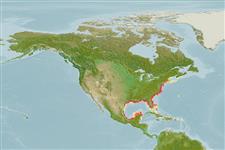>
Blenniiformes (Blennies) >
Blenniidae (Combtooth blennies) > Salariinae
Etymology: Hypsoblennius: Greek, hypsi = high + Greek, blennios = mucus (Ref. 45335).
More on author: Lesueur.
Environment: milieu / climate zone / depth range / distribution range
Ökologie
seewasser riff-verbunden. Temperate; 46°N - 18°N, 98°W - 62°W
Western Atlantic: New Jersey (occasionally Nova Scotia in Canada) to Texas, including southern Florida in USA.
Size / Gewicht / Alter
Maturity: Lm ? range ? - ? cm
Max length : 10.0 cm TL Männchen/unbestimmt; (Ref. 7251)
Rückenflossenstacheln (insgesamt) : 11 - 13; Rückenflossenweichstrahlen (insgesamt) : 13 - 16; Afterflossenstacheln: 2. Gill opening extending ventrally to opposite 7th-11th pectoral-fin ray; segmented dorsal-fin rays 13-16; segmented pelvic-fin rays 3; last dorsal-fin spine 8.5-15.5% SL; dorsal-fin spines robust and stiff; no elongate fleshy flap present posteriorly on lower lip; infraorbital bones 5-5; upper lip without free dorsal margin extending around snout; fleshy lobes of lower lip almost linear in lateral view and separated anterioventrally by a broad smooth area; bony interorbital width comparatively wider; dark spot usually present in spinous dorsal fin and centered on second spine; mandibular pores 4.
Adults inhabit oyster reefs and rocky shores. Oviparous. Eggs are demersal and adhesive (Ref. 205), and are attached to the substrate via a filamentous, adhesive pad or pedestal (Ref. 94114). Larvae are planktonic, often found in shallow, coastal waters (Ref. 94114).
Life cycle and mating behavior
Maturities | Fortpflanzung | Spawnings | Egg(s) | Fecundities | Larven
Oviparous, distinct pairing (Ref. 205).
Robins, C.R. and G.C. Ray, 1986. A field guide to Atlantic coast fishes of North America. Houghton Mifflin Company, Boston, U.S.A. 354 p. (Ref. 7251)
IUCN Rote Liste Status (Ref. 130435)
Bedrohung für Menschen
Harmless
Nutzung durch Menschen
Fischereien: nicht kommerziell
Tools
Zusatzinformationen
Download XML
Internet Quellen
Estimates based on models
Preferred temperature (Ref.
123201): 12.5 - 26.1, mean 23.7 °C (based on 188 cells).
Phylogenetic diversity index (Ref.
82804): PD
50 = 0.5000 [Uniqueness, from 0.5 = low to 2.0 = high].
Bayesian length-weight: a=0.00741 (0.00335 - 0.01640), b=3.02 (2.83 - 3.21), in cm total length, based on LWR estimates for this (Sub)family-body shape (Ref.
93245).
Trophic level (Ref.
69278): 2.8 ±0.2 se; based on size and trophs of closest relatives
Widerstandsfähigkeit (Ref.
120179): hoch, Verdopplung der Population dauert weniger als 15 Monate. (Preliminary K or Fecundity.).
Fishing Vulnerability (Ref.
59153): Low vulnerability (10 of 100).
Nutrients (Ref.
124155): Calcium = 51.5 [16.8, 99.3] mg/100g; Iron = 0.286 [0.140, 0.560] mg/100g; Protein = 18.4 [17.1, 19.7] %; Omega3 = 0.233 [0.105, 0.504] g/100g; Selenium = 5.02 [1.83, 13.23] μg/100g; VitaminA = 86 [18, 428] μg/100g; Zinc = 1.1 [0.7, 1.8] mg/100g (wet weight);
